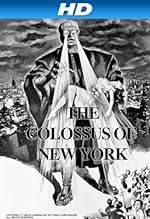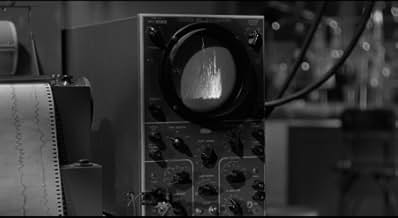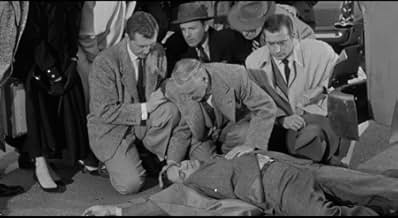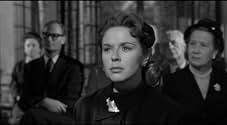ÉVALUATION IMDb
5,9/10
1,4 k
MA NOTE
Ajouter une intrigue dans votre langueA brilliant surgeon encases his dead son's brain in a large robot body, with unintended results...A brilliant surgeon encases his dead son's brain in a large robot body, with unintended results...A brilliant surgeon encases his dead son's brain in a large robot body, with unintended results...
George Douglas
- Official
- (uncredited)
Roy Engel
- Police Inspector
- (uncredited)
Sam Harris
- Man at Funeral Service
- (uncredited)
Larry Kerr
- Reporter
- (uncredited)
Harold Miller
- Airport Accident Extra
- (uncredited)
Dick Nelson
- Charles - Chauffeur-Butler
- (uncredited)
Foster H. Phinney
- Reporter
- (uncredited)
Jack Richardson
- Reporter
- (uncredited)
Court Shepard
- Reporter
- (uncredited)
Charles Sherlock
- Airline Pilot
- (uncredited)
Bert Stevens
- Airport Accident Extra
- (uncredited)
Avis en vedette
The conventional wisdom is that this is a mediocre movie. Yet I find it strangely affecting. A man's brain is placed in a large robotic body, but it's not the usual mad scientist bit. The scientist is a desperate father and the brain belongs to his son (Ross Martin), killed(?) in an automobile accident.
Encased in his robotic body, the son longs to see his own son. These are mad scientists with family values!
The only music in the movie is provided by a lone piano. The motivation for this decision was probably more economical than artistic but Nathan Van Cleave's score echoes the fear and melancholy that permeates the film perfectly.
Not a great film, but one every sci-fi and horror movie fan should see.
Encased in his robotic body, the son longs to see his own son. These are mad scientists with family values!
The only music in the movie is provided by a lone piano. The motivation for this decision was probably more economical than artistic but Nathan Van Cleave's score echoes the fear and melancholy that permeates the film perfectly.
Not a great film, but one every sci-fi and horror movie fan should see.
Along with a few others, I too, must chime in with my 'thumbs up' opinion of this lost classic. I was fortunate to see nearly ALL of the horror/sci-fi 'Classics' in theaters during the 50's binge..when there was a new double feature nearly every other week.
This one, stands quite a bit above all the others. The creep factor is high and it has some truly haunting moments. The piano score just adds to the muted terror. Cheap? Yep. But I think that adds to the atmosphere.
Sure, I was a 'kid' when I saw all of these back then, but only a handful of these films were 'great'. 'Colossus' is hands-down one of the best of that era. If you watch it in the proper context, I'm sure you will agree.
This one, stands quite a bit above all the others. The creep factor is high and it has some truly haunting moments. The piano score just adds to the muted terror. Cheap? Yep. But I think that adds to the atmosphere.
Sure, I was a 'kid' when I saw all of these back then, but only a handful of these films were 'great'. 'Colossus' is hands-down one of the best of that era. If you watch it in the proper context, I'm sure you will agree.
Paramount produced this fascinating, low-budget gem in 1958 and release it with a second feature which was tailor-made to go with it (see `The Space Children'). They played together at drive-in theaters nation wide, and thousand of kids like me watched them both in wide-eyed wonder.
Young viewers (15 to 25 years old) who watch either of these films today tend to totally miss the point. `The Colossus of New York' is an admirable and well-crafted exploration of concepts that were years ahead of their time: ideas like sensory deprivation, organ transplants, psychic powers, and others. This movie is NOT simply a Frankenstein rehash (as several misguided reviewers have claimed).
The story is about a noble, humanitarian genius whose brain is placed in an unfeeling robot body. The film invites the viewer to ponder what makes each of us the sensitive and compassionate person we are (or should be).
If `The Colossus of New York' seems hockey and corny to you, remember that it was designed for an audience -- and a culture -- that existed almost half a century ago. If you have the maturity and the intelligence to translate this message from a by-gone age, you'll benefit from your efforts.
If not . . . well, it's your loss.
Young viewers (15 to 25 years old) who watch either of these films today tend to totally miss the point. `The Colossus of New York' is an admirable and well-crafted exploration of concepts that were years ahead of their time: ideas like sensory deprivation, organ transplants, psychic powers, and others. This movie is NOT simply a Frankenstein rehash (as several misguided reviewers have claimed).
The story is about a noble, humanitarian genius whose brain is placed in an unfeeling robot body. The film invites the viewer to ponder what makes each of us the sensitive and compassionate person we are (or should be).
If `The Colossus of New York' seems hockey and corny to you, remember that it was designed for an audience -- and a culture -- that existed almost half a century ago. If you have the maturity and the intelligence to translate this message from a by-gone age, you'll benefit from your efforts.
If not . . . well, it's your loss.
An elderly doctor (Otto Kruger) transplants his genius son's brain inside the head of an over-sized robot after the young scientist is killed in an auto accident. The revitalized Colossus retains our sympathy but eventually grows somewhat mad and kills people by shooting them with rays from out of his eye fixtures. I must say that even though I don't typically get scared watching horror movies, the very first time I heard the robot's unhinged and desperately static-tinged voice as he's being given life, it sent absolute shivers of discomfort down my spine - I was terrified! I liked the look of the robot, and the unnatural way he's sometimes photographed jerkily lumbering along (which sometimes sloppily reflected the other characters' motions in the same scenes). Just really creepy. If they could have consistently managed to photograph the other people's reactionary movements at "normal pace" while the robot only was moving awkwardly, it would have been even more weirdly effective. The production values are very cheap, and there is only a modest piano soundtrack to accompany the activities, yet somehow it all works out effectively enough for this movie. Old man Otto Kruger was probably embarrassed to be acting in this, but I enjoyed him here just as I enjoyed his turn as a mad doc in THE JUNGLE CAPTIVE. This movie's also got unintentional chuckles, too (I was in hysterics at Kruger's silly looking-down expression at the United Nations of the film when his robot meets its fate). Fun low budgeted '50s Flick, now one of my favorites from the genre. **1/2 out of ****
The impressive title work is the viewer's first clue that producer William Alland and director Eugene Lourie squeezed considerable artistry and style from a shoestring budget. Look past the economic limitations; the suspenseful and imaginative story involves the death of a humanitarian genius whose father (a famous surgeon) and brother (a robotics expert) team up to keep the genius' brain alive in a robot body (well designed by ace effects artist John P. Fulton). The film's message concerns the nature of the soul and the role which physical sensations play in making humans act humane. Other affects by Fulton include one of sci-fi cinema's best death rays. All in all, a moving and intelligent movie
Le saviez-vous
- AnecdotesThe Colossus costume was eight feet tall, weighed 160 pounds and was made from burlap, plastic, rubber and fine chicken wire. Inside, there were batteries, cables, air tanks and oxygen tubes.
- GaffesWhen Jeremy (the Colossus) crashes through the glass wall at the end of the movie, the very next scene there is a woman lying on the floor and the man to the left of her looks down at her. In the scene following, the Colossus starts shooting eye beams. The eye beam then hits the woman, now standing, and she falls to the floor, in the same position.
- Générique farfeluThe opening credits text rises out of New York harbor, as its reflection on the water sinks to the bottom of the screen.
Meilleurs choix
Connectez-vous pour évaluer et surveiller les recommandations personnalisées
- How long is The Colossus of New York?Propulsé par Alexa
Détails
- Date de sortie
- Pays d’origine
- Langue
- Aussi connu sous le nom de
- Der Koloss von New York
- Lieux de tournage
- société de production
- Consultez plus de crédits d'entreprise sur IMDbPro
- Durée1 heure 10 minutes
- Couleur
- Rapport de forme
- 1.66 : 1
Contribuer à cette page
Suggérer une modification ou ajouter du contenu manquant

Lacune principale
By what name was The Colossus of New York (1958) officially released in Canada in English?
Répondre































